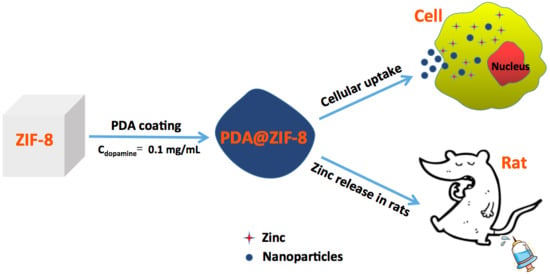New Insight into Polydopamine@ZIF-8 Nanohybrids: A Zinc-Releasing Container for Potential Anticancer Activity
Abstract
:1. Introduction
2. Experiments
2.1. Materials
2.2. Synthesis of ZIF-8 Nanocrystals
2.3. Fabrication of PDA@ZIF-8 Nanohybrids
2.4. Preparation of PDA@ZIF-8@Melphalan Nanohybrids
2.5. General Characterization
2.6. Confocal Laser Scanning Microscopy
2.7. Cytotoxicity Assay of ZIF-8 and PDA@ZIF-8
2.8. The Determination of Zinc Concentration
2.9. In Vitro Zinc Release of ZIF-8 and PDA@ZIF-8
2.10. In Vivo Zinc Release of ZIF-8 and PDA@ZIF-8
2.11. In Vitro Anti-Tumor Activity
2.12. Statistical Analysis
3. Results and Discussion
3.1. SEM and TEM Analysis
3.2. In Vitro Cytotoxicity Evaluation
3.3. Zinc Release Investigation in HCT8 and HEK293
3.4. Zinc Release Investigation in Rats
3.5. Anti-Tumoral Activity for MCF-7 Cells
3.6. In Vitro Cellular Uptake of PDA@ZIF-8@Melphalan
4. Conclusions
Author Contributions
Acknowledgments
Conflicts of Interest
References
- Prasad, A.S. Biochemistry of Zinc; Plenum: New York, NY, USA, 1993. [Google Scholar]
- Hoang, B.X.; Han, B.; Shaw, D.G.; Nimni, M. Zinc as a possible preventive and therapeutic agent in pancreatic, prostate, and breast cancer. Eur. J. Cancer Prev. 2016, 25, 457–461. [Google Scholar] [CrossRef] [PubMed]
- Song, Y.; Ho, E. Zinc and prostatic cancer. Curr. Opin. Clin. Nutr. Metab. Care 2009, 12, 640–645. [Google Scholar]
- Epstein, M.M.; Kasperzyk, J.L.; Andrén, O.; Giovannucci, E.L.; Wolk, A.; Håkansson, N.; Andersson, S.O.; Johansson, J.E.; Fall, K.; Mucci, L.A. Dietary zinc and prostate cancer survival in a Swedish cohort. Am. J. Clin. Nutr. 2011, 93, 586–593. [Google Scholar] [CrossRef] [PubMed]
- Pavithra, V.; Sathisha, T.G.; Kasturi, K.; Mallika, D.S.; Amos, S.J.; Ragunatha, S. Serum levels of metal ions in female patients with breast cancer. J. Clin. Diagn. Res. 2015, 9, BC25–BC27. [Google Scholar] [CrossRef] [PubMed]
- Jaworska-Bieniek, K.; Jakubowska, A.; Durda, K.; Huzarski, T.; Serrano-Fernandez, P.; Sukiennicki, G.; Muszyńska, M.; Byrski, T.; Gronwald, J.; Gupta, S.; et al. Selenium (Se) and breast cancer risk. Hered. Cancer Clin. Pract. 2012, 10, A4. [Google Scholar] [CrossRef]
- Costello, L.C.; Franklin, R.B. A review of the current status and concept of the emerging implications of zinc and zinc transporters in the development of pancreatic cancer. Pancreat. Disord. Ther. 2013. [Google Scholar] [CrossRef] [PubMed]
- Jayaraman, A.K.; Jayaraman, S. Increased level of exogenous zinc induces cytotoxicity and up-regulates the expression of the ZnT-1 zinc transporter gene in pancreatic cancer cells. J. Nutr. Biochem. 2011, 22, 79–88. [Google Scholar] [CrossRef] [PubMed]
- Fong, L.Y.Y.; Nguyen, V.T.; Farber, J.L. Esophageal cancer prevention in zinc-deficient rats: Rapid induction of apoptosis by replenishing zinc. J. Natl. Cancer Inst. 2001, 93, 1525–1533. [Google Scholar] [CrossRef] [PubMed]
- Hamano, H.; Yoshinaga, K.; Tanaka, T.; Eta, R.; Horii, T.; Kawabata, Y.; Furuta, S.; Takei, M. Polaprezinc, a zinc compound, is distributed to the lingual epithelium and increases its zinc concentration in zinc-deficient rats. Life Sci. 2009, 85, 759–764. [Google Scholar] [CrossRef] [PubMed]
- Phan, A.; Doonan, C.J.; Uribe-Romo, F.J.; Knobler, C.B.; O’keeffe, M.; Yaghi, O.M. Synthesis, structure, and carbon dioxide capture properties of zeolitic imidazolate frameworks. Acc. Chem. Res. 2010, 43, 58–67. [Google Scholar] [CrossRef] [PubMed]
- Liang, K.; Ricco, R.; Doherty, C.M.; Styles, M.J.; Bell, S.; Kirby, N.; Mudie, S.; Haylock, D.; Hill, A.J.; Doonan, C.J.; et al. Biomimetic mineralization of metal-organic frameworks as protective coatings for biomacromolecules. Nat. Commun. 2015, 6, 7240. [Google Scholar] [CrossRef] [PubMed]
- Liang, K.; Richardson, J.J.; Cui, J.; Caruso, F.; Doonan, C.J.; Falcaro, P. Metal–organic framework coatings as cytoprotective exoskeletons for living cells. Adv. Mater. 2016, 28, 7910–7914. [Google Scholar] [CrossRef] [PubMed]
- Liang, K.; Richardson, J.J.; Doonan, C.J.; Mulet, X.; Ju, Y.; Cui, J.; Caruso, F.; Falcaro, P. An Enzyme-Coated Metal–Organic Framework Shell for Synthetically Adaptive Cell Survival. Angew. Chem. Int. Ed. 2017, 129, 8510–8515. [Google Scholar] [CrossRef] [PubMed]
- Richardson, J.J.; Liang, K. Nano-Biohybrids: In Vivo Synthesis of Metal–Organic Frameworks inside Living Plants. Small 2018, 14, 1702958. [Google Scholar] [CrossRef] [PubMed]
- Liang, K.; Carbonell, C.; Styles, M.J.; Ricco, R.; Cui, J.; Richardson, J.J.; Maspoch, D.; Caruso, F.; Falcaro, P. Biomimetic replication of microscopic metal–organic framework patterns using printed protein patterns. Adv. Mater 2015, 27, 7293–7298. [Google Scholar] [CrossRef] [PubMed]
- Zheng, H.; Zhang, Y.; Liu, L.; Wan, W.; Guo, P.; Nyström, A.M.; Zou, X. One-pot synthesis of metal–organic frameworks with encapsulated target molecules and their applications for controlled drug delivery. J. Am. Chem. Soc. 2016, 138, 962–968. [Google Scholar] [CrossRef] [PubMed]
- Liang, K.; Wang, R.; Boutter, M.; Doherty, C.M.; Mulet, X.; Richardson, J.J. Biomimetic mineralization of metal–organic frameworks around polysaccharides. Chem. Commun. 2017, 53, 1249–1252. [Google Scholar] [CrossRef] [PubMed]
- Lyu, F.; Zhang, Y.; Zare, R.N.; Ge, J.; Liu, Z. One-pot synthesis of protein-embedded metal–organic frameworks with enhanced biological activities. Nano Lett. 2014, 14, 5761–5765. [Google Scholar] [CrossRef] [PubMed]
- Ren, H.; Zhang, L.; An, J.; Wang, T.; Li, L.; Si, X.; He, L.; Wu, X.; Wang, C.; Su, Z. Polyacrylic acid@ zeolitic imidazolate framework-8 nanoparticles with ultrahigh drug loading capability for pH-sensitive drug release. Chem. Commun. 2014, 50, 1000–1002. [Google Scholar] [CrossRef] [PubMed]
- Ran, J.; Xiao, L.; Wu, W.; Liu, Y.; Qiu, W.; Wu, J. Zeolitic imidazolate framework-8 (ZIF-8) as a sacrificial template: One-pot synthesis of hollow poly (dopamine) nanocapsules and yolk-structured poly (dopamine) nanocomposites. Nanotechnology 2016, 28, 055604. [Google Scholar] [CrossRef] [PubMed]
- Liu, X.; Cao, J.; Li, H.; Li, J.; Jin, Q.; Ren, K.; Ji, J. Mussel-inspired polydopamine: a biocompatible and ultrastable coating for nanoparticles in vivo. ACS Nano 2013, 7, 9384–9395. [Google Scholar] [CrossRef] [PubMed]
- Ling, D.; Park, W.; Park, Y.I.; Lee, N.; Li, F.; Song, C.; Yang, S.G.; Choi, S.H.; Na, K.; Hyeon, T. Multiple-Interaction Ligands Inspired by Mussel Adhesive Protein: Synthesis of Highly Stable and Biocompatible Nanoparticles. Angew. Chem. Int. Ed. 2011, 50, 11360–11365. [Google Scholar] [CrossRef] [PubMed]
- Ding, X.; Liu, J.; Li, J.; Wang, F.; Wang, Y.; Song, S.; Zhang, H. Polydopamine coated manganese oxide nanoparticles with ultrahigh relaxivity as nanotheranostic agents for magnetic resonance imaging guided synergetic chemo-/photothermal therapy. Chem. Sci. 2016, 7, 6695–6700. [Google Scholar] [CrossRef] [PubMed]
- Zhou, W.H.; Lu, C.H.; Guo, X.C.; Chen, F.R.; Yang, H.H.; Wang, X.R. Mussel-inspired molecularly imprinted polymer coating superparamagnetic nanoparticles for protein recognition. J. Mater. Chem. 2010, 20, 880–883. [Google Scholar] [CrossRef]
- Li, Z.; Zeng, H.C. Surface and bulk integrations of single-layered Au or Ag nanoparticles onto designated crystal planes {110} or {100} of ZIF-8. Chem. Mater. 2013, 25, 1761–1768. [Google Scholar] [CrossRef]
- Shearier, E.; Cheng, P.; Zhu, Z.; Bao, J.; Hu, Y.H.; Zhao, F. Surface defection reduces cytotoxicity of Zn (2-methylimidazole) 2 (ZIF-8) without compromising its drug delivery capacity. RSC Adv. 2016, 6, 4128–4135. [Google Scholar] [CrossRef] [PubMed]
- Plum, L.M.; Rink, L.; Haase, H. The essential toxin: Impact of zinc on human health. Int. J. Environ. Res. Public Health 2010, 7, 1342–1365. [Google Scholar] [CrossRef] [PubMed]
- Chu, Y.; Hou, J.; Boyer, C.; Richardson, J.J.; Liang, K.; Xu, J. Biomimetic synthesis of coordination network materials: Recent advances in MOFs and MPNs. Mater. Today 2018, 10, 93–105. [Google Scholar] [CrossRef]
- Banudevi, S.; Elumalai, P.; Arunkumar, R.; Senthilkumar, K.; Gunadharini, D.N.; Sharmila, G.; Arunakaran, J. Chemopreventive effects of zinc on prostate carcinogenesis induced by N-methyl-N-nitrosourea and testosterone in adult male Sprague-Dawley rats. J. Cancer Res. Clin. 2011, 137, 677–686. [Google Scholar] [CrossRef] [PubMed]
- Dam, J.; Ismail, Z.; Kurebwa, T.; Gangat, N.; Harmse, L.; Marques, H.M.; Lemmerer, A.; Bode, M.L.; de Koning, C.B. Synthesis of copper and zinc 2-(pyridin-2-yl) imidazo [1,2-a] pyridine complexes and their potential anticancer activity. Eur. J. Med. Chem. 2017, 126, 353–368. [Google Scholar] [CrossRef] [PubMed]
- Hassan, H.F.; Mansour, A.M.; Abo-Youssef, A.M.; Elsadek, B.E.; Messiha, B.A. Zinc oxide nanoparticles as a novel anticancer approach; in vitro and in vivo evidence. Clin. Exp. Pharmacol. Physiol. 2017, 44, 235–243. [Google Scholar] [CrossRef] [PubMed]
- Choi, S.; Cui, C.; Luo, Y.; Kim, S.H.; Ko, J.K.; Huo, X.; Ma, J.; Fu, L.W.; Souza, R.F.; Korichneva, I.; et al. Selective inhibitory effects of zinc on cell proliferation in esophageal squamous cell carcinoma through Orai1. FASEB J. 2018, 32, 404–416. [Google Scholar] [CrossRef] [PubMed]
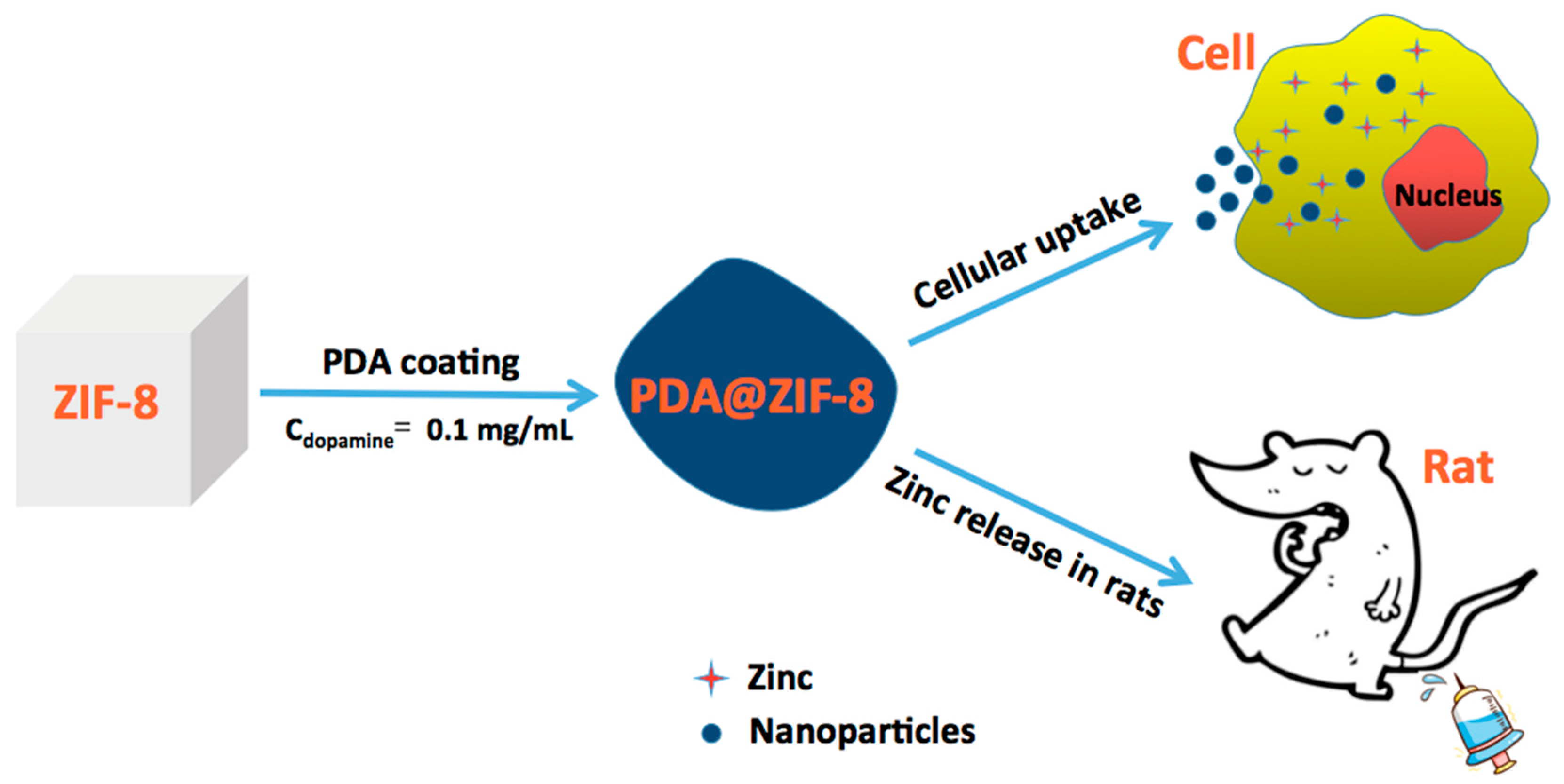


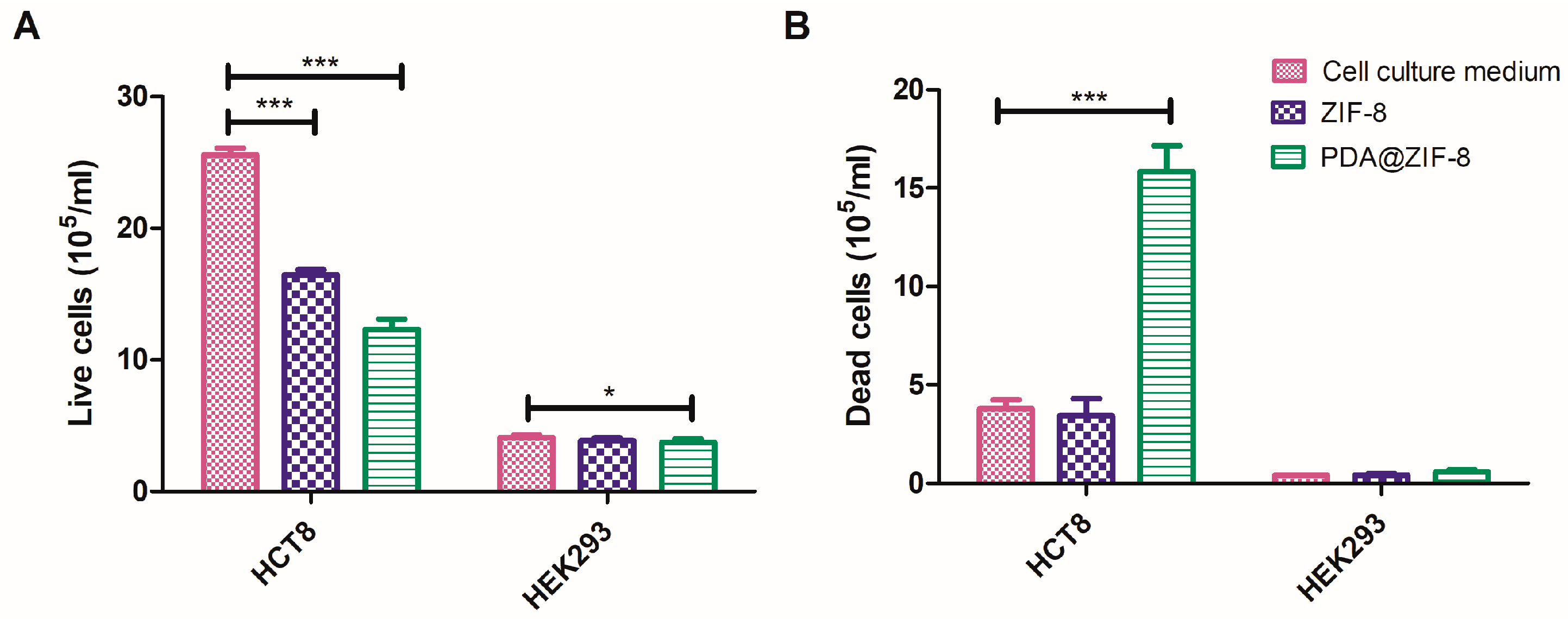
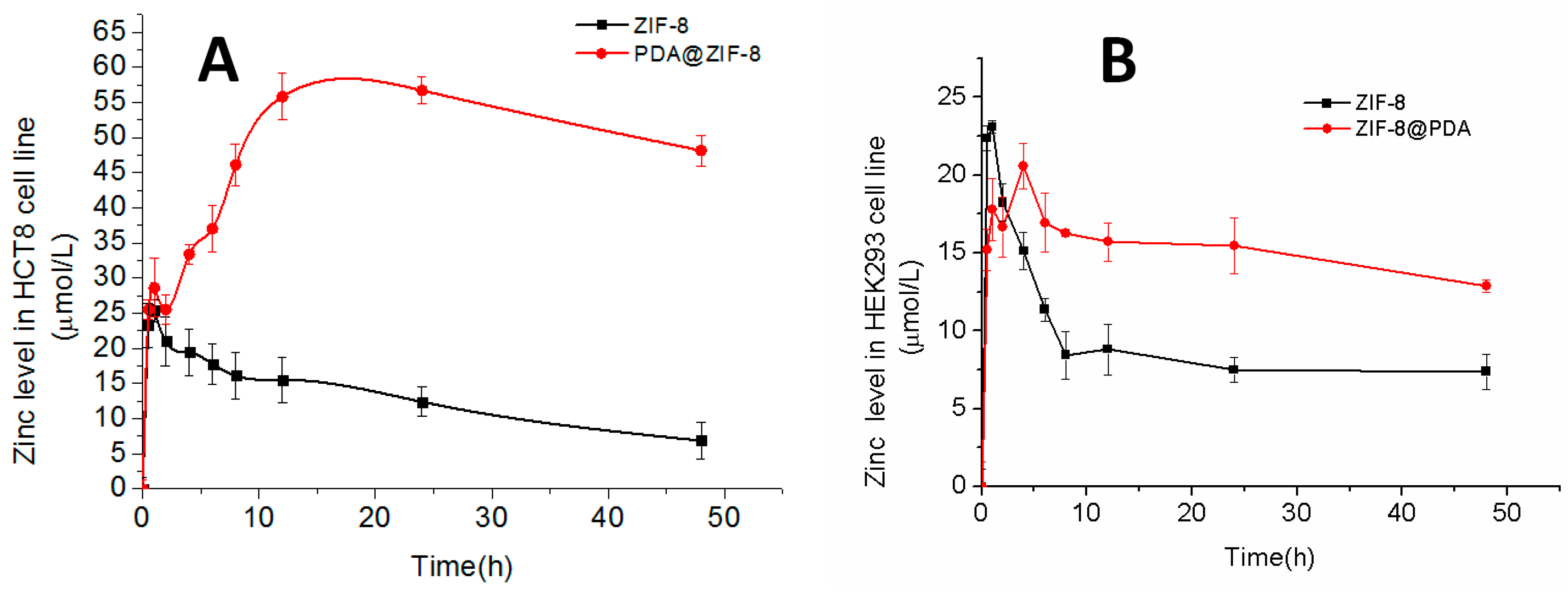
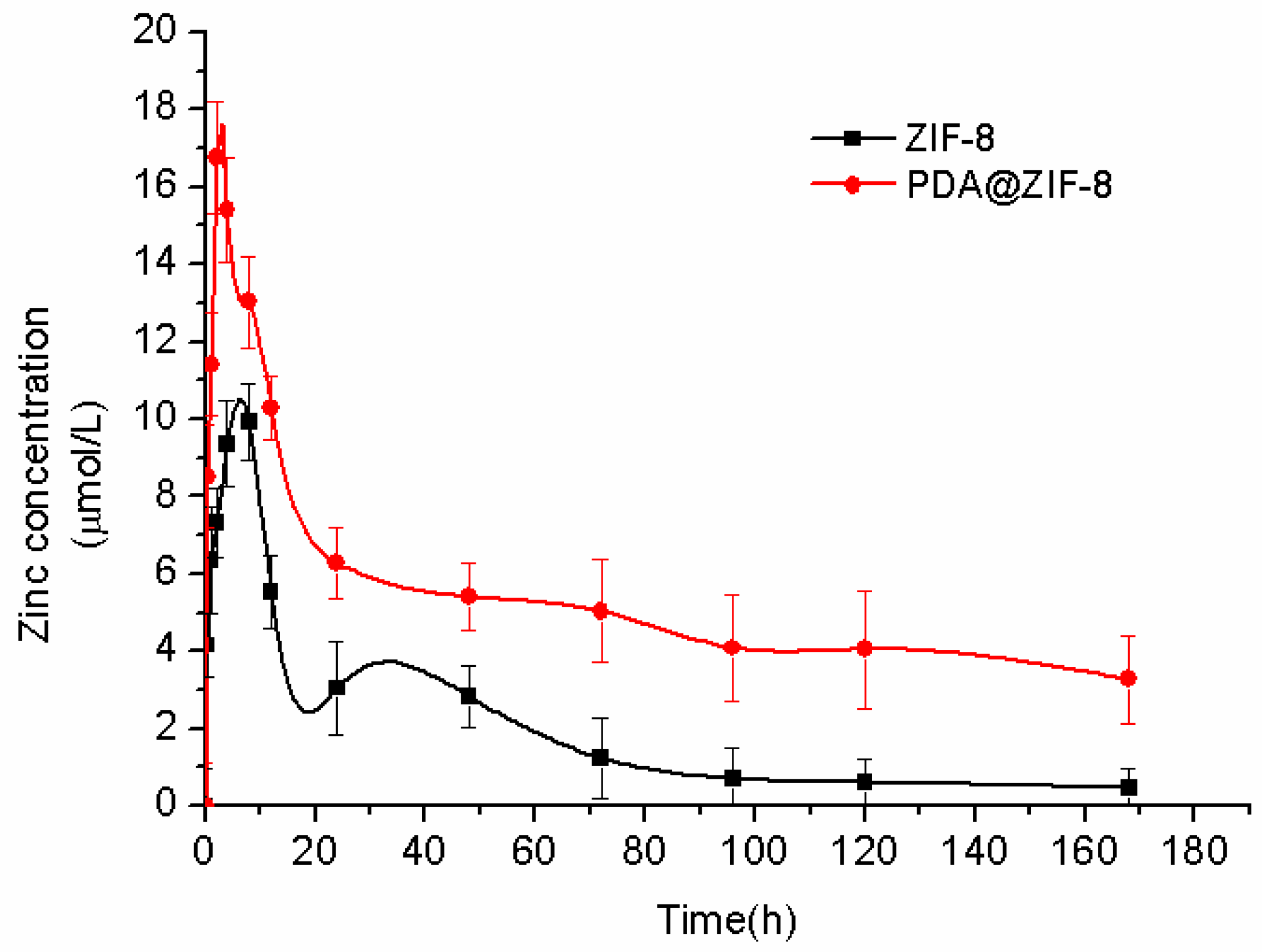
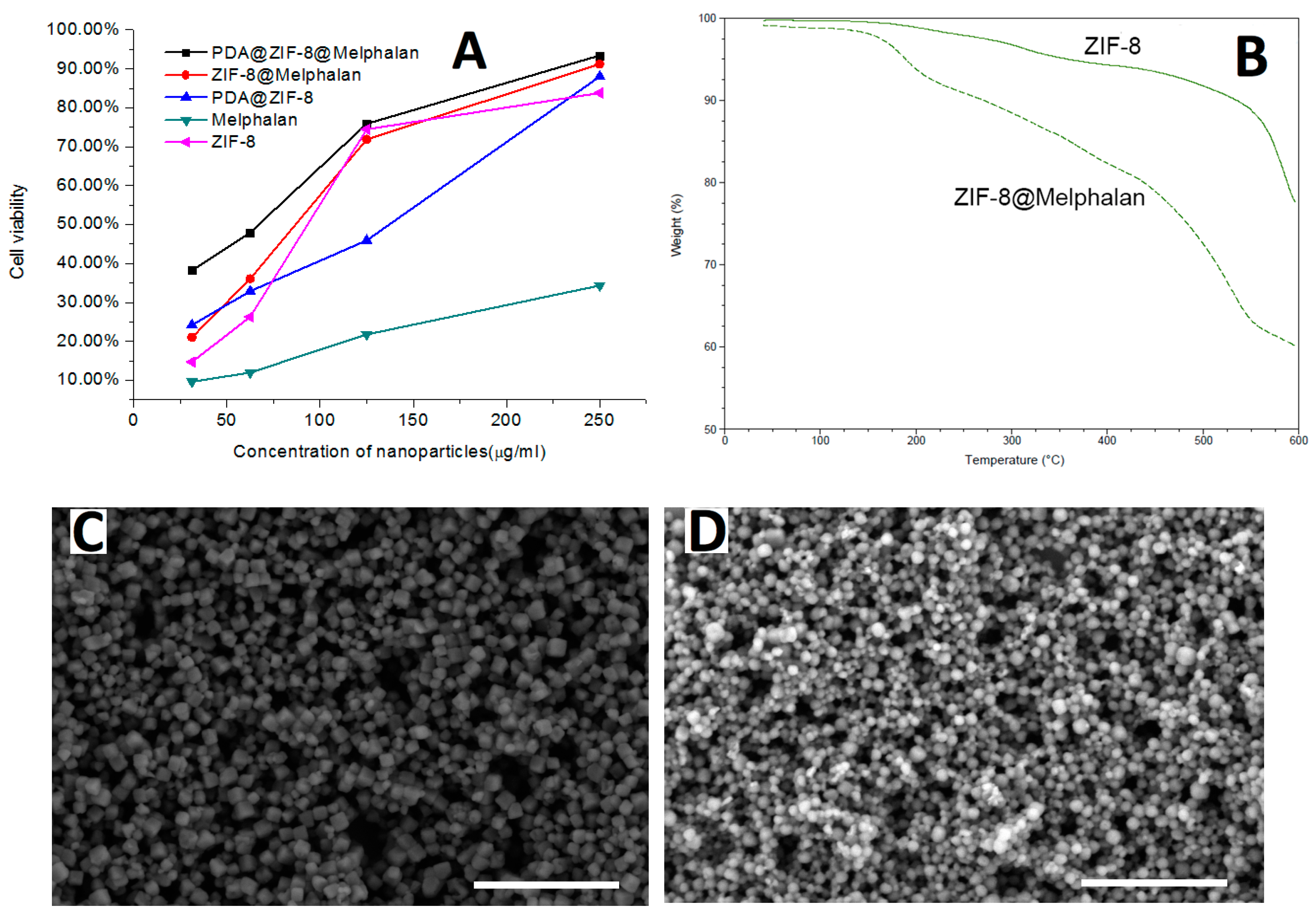
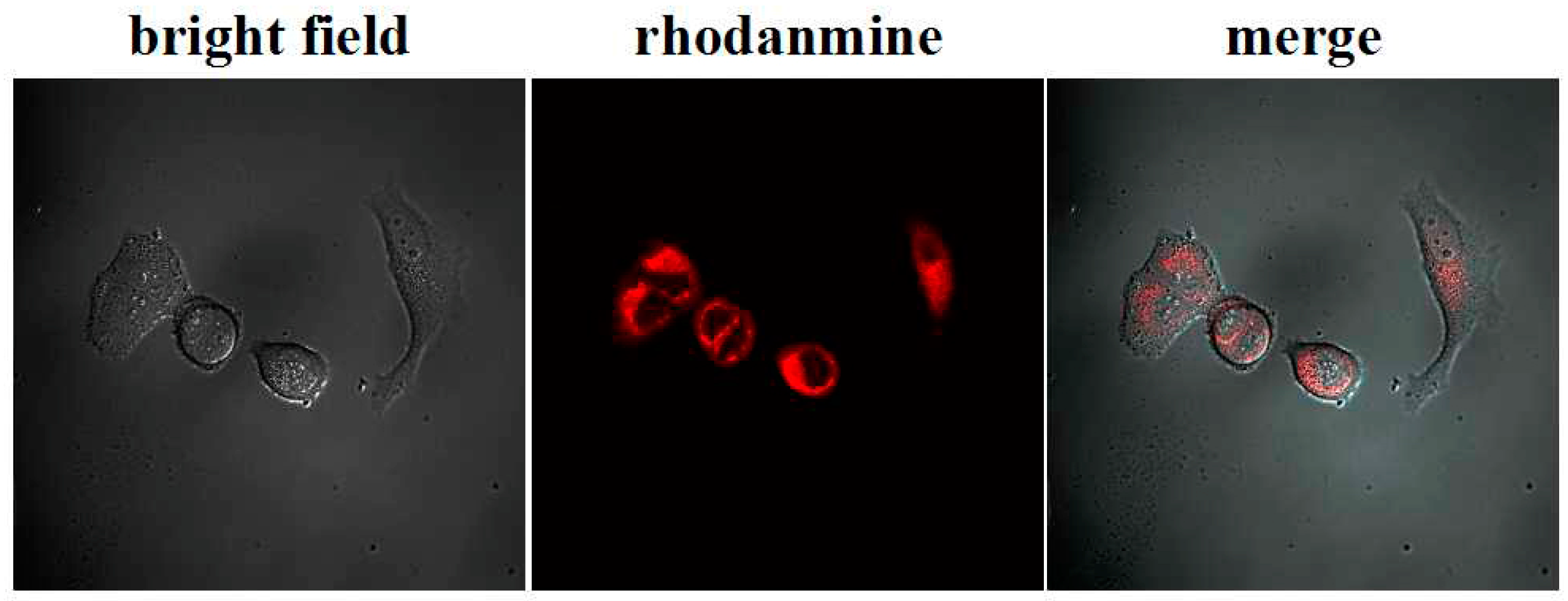
| Sample | Average Particle Size ‡ (nm) | BET Surface Area (m2 g−1) | Pore Volume (cc g−) |
|---|---|---|---|
| ZIF-8 | 90 ± 15 | 1278 | 1.24 |
| † PDA@ZIF-8 | 100 ± 12 | 1044 | 0.40 |
| Parameter | Unit | ZIF-8 | PDA@ZIF-8 |
|---|---|---|---|
| AUC | μmol × h/L | 339.44 ± 66.37 | 730.29 ± 93.13 |
| Cmax | μmol/L | 10.43 ± 2.77 | 17.17 ± 2.23 |
| Tmax | h | 8.20 ± 1.00 | 3.67 ± 0.58 |
| MRT | h | 47.80 ± 8.21 | 64.99 ± 3.24 |
| T1/2 | h | 78.89 ± 38.13 | 173.05 ± 21.92 |
© 2018 by the authors. Licensee MDPI, Basel, Switzerland. This article is an open access article distributed under the terms and conditions of the Creative Commons Attribution (CC BY) license (http://creativecommons.org/licenses/by/4.0/).
Share and Cite
Ran, J.; Wang, C.; Zhang, J.; Wang, W.; Xiao, L.; Jia, S.; Wang, Z.; Wu, W.; Xiao, J.; Wu, X. New Insight into Polydopamine@ZIF-8 Nanohybrids: A Zinc-Releasing Container for Potential Anticancer Activity. Polymers 2018, 10, 476. https://doi.org/10.3390/polym10050476
Ran J, Wang C, Zhang J, Wang W, Xiao L, Jia S, Wang Z, Wu W, Xiao J, Wu X. New Insight into Polydopamine@ZIF-8 Nanohybrids: A Zinc-Releasing Container for Potential Anticancer Activity. Polymers. 2018; 10(5):476. https://doi.org/10.3390/polym10050476
Chicago/Turabian StyleRan, Jingyu, Cong Wang, Jinjuan Zhang, Wei Wang, Lihua Xiao, Shaoyi Jia, Ze Wang, Weidang Wu, Jun Xiao, and Xinyu Wu. 2018. "New Insight into Polydopamine@ZIF-8 Nanohybrids: A Zinc-Releasing Container for Potential Anticancer Activity" Polymers 10, no. 5: 476. https://doi.org/10.3390/polym10050476
APA StyleRan, J., Wang, C., Zhang, J., Wang, W., Xiao, L., Jia, S., Wang, Z., Wu, W., Xiao, J., & Wu, X. (2018). New Insight into Polydopamine@ZIF-8 Nanohybrids: A Zinc-Releasing Container for Potential Anticancer Activity. Polymers, 10(5), 476. https://doi.org/10.3390/polym10050476




